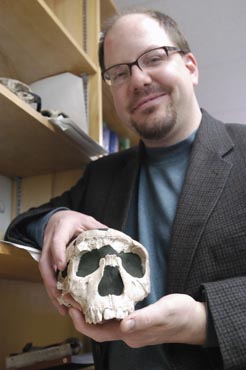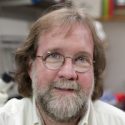Genome study places modern humans in the evolutionary fast lane
Countering a common theory that human evolution has slowed to a crawl or even stopped in modern humans, a new study examining data from an international genomics project describes the past 40,000 years as a time of supercharged evolutionary change, driven by exponential population growth and cultural shifts.

Anthropologist John Hawks estimates that positive selection in the past 5,000 years has occurred at a rate roughly 100 times higher than any other period of human evolution. His research is based on analysis of international genetic data that provides evidence of recent positive selection. The finding is likely to spark a rethinking of common assumptions about evolution being relaxed in modern humans.
Photo: Michael Forster Rothbart
In a study published in the Dec. 10 issue of the Proceedings of the National Academy of Sciences (PNAS), a team led by UW–Madison anthropologist John Hawks estimates that positive selection just in the past 5,000 years alone — around the period of the Stone Age — has occurred at a rate roughly 100 times higher than any other period of human evolution. Many of the new genetic adjustments are occurring around changes in the human diet brought on by the advent of agriculture, and resistance to epidemic diseases that became major killers after the growth of human civilizations.
"In evolutionary terms, cultures that grow slowly are at a disadvantage, but the massive growth of human populations has led to far more genetic mutations," says Hawks. "And every mutation that is advantageous to people has a chance of being selected and driven toward fixation. What we are catching is an exceptional time."
The findings may lead to a very broad rethinking of human evolution, Hawks says, especially in the view that modern culture has essentially relaxed the need for physical genetic changes in humans to improve survival. Adds Hawks: "We are more different genetically from people living 5,000 years ago than they were different from Neanderthals."
While the correlation between population size and natural selection is nothing new — it was a core premise of Charles Darwin, Hawks says — the ability to bring quantifiable evidence to the table is a new and exciting outgrowth of the Human Genome Project.
Along with co-author Gregory Cochran, an anthropologist at the University of Utah; and Eric Wang of Affymetrix, Inc., in Santa Clara, Cal.; Hawks analyzed data from the International HapMap Project, short for haplotype mapping. This project is working to catalog genetic similarities and differences in human beings by studying genes from distinct sample populations around the globe. While the HapMap will ultimately be used to identify genes that affect human health, it can also provide a road map of genetic variation from the ancestral human population.
While more than 99 percent of the human genome is common across all humans, the HapMap project is cataloguing the individual differences in DNA called single nucleotide polymorphisms (SNPs). The project has mapped roughly 4 million of the estimated 10 million SNPs in the human genome. More importantly, it is identifying different regions of DNA, or haplotypes, that contain a large number of SNPs and are shared by multiple individuals.
In the hunt for recent genetic variation in this map, Hawks’ research focuses on a phenomenon called linkage disequilibrium (LD). These are places on the genome where genetic variations are occurring more often than can be accounted for by chance, usually because these changes are affording some kind of selection advantage.
The researchers identify recent genetic change by finding long blocks of DNA base pairs that are connected. Because human DNA is constantly being reshuffled through recombination, a long, uninterrupted segment of LD is usually evidence of positive selection. Linkage disequilibrium decays quickly as recombination occurs across many generations, so finding these uninterrupted segments is strong evidence of recent adaptation, Hawks says.
Employing this test, the researchers found evidence of recent selection on approximately 1,800 genes, or 7 percent of all human genes.
This finding runs counter to conventional wisdom in many ways, Hawks says. For example, there’s a strong record of skeletal changes that clearly show people became physically smaller, and their brains and teeth are also smaller. This is generally seen as a sign of relaxed selection — that size and strength are no longer key to survival.
But other pathways for evolution have opened, Hawks says, and genetic changes are now being driven by major changes in human culture. One good example is lactase, the gene that helps people digest milk. This gene normally declines and stops activity about the time one becomes a teenager, Hawks says. But northern Europeans developed a variation of the gene that allowed them to drink milk their whole lives — a relatively new adaptation that is directly tied to the advance of domestic farming and use of milk as an agricultural product.
The biggest new pathway for selection relates to disease resistance, Hawks says. As people starting living in much larger groups and settling in one place roughly 10,000 years ago, epidemic diseases such as malaria, smallpox and cholera began to dramatically shift mortality patterns in people. Malaria is one of the clearest examples, Hawks says, given that there are now more than two dozen identified genetic adaptations that relate to malaria resistance, including an entirely new blood type known as the Duffy blood type.
Another recently discovered gene, CCR5, originated about 4,000 years ago and now exists in about 10 percent of the European population. It was discovered recently because it makes people resistant to HIV/AIDS. But its original value might have come from obstructing the pathway for smallpox.
"There are many things under selection that are making it harder for pathogens to kill us," Hawks says.
Population growth is making all of this change occur much faster, Hawks says, giving a nod to Charles Darwin. When Darwin wrote in "Origin of the Species" about challenges in animal breeding, he always emphasized that herd size "is of the highest importance for success" because large populations have more genetic variation, Hawks says.
The parallel to humans is obvious: The human population has grown from a few million people 10,000 years ago to about 200 million people at A.D. 0, to 600 million people in the year 1700, to more than 6.5 billion today. Prior to these times, the population was so small for so long that positive selection occurred at a glacial pace, Hawks says.
"What’s really amazing about humans, that is not true with most other species, is that for a long time we were just a little ape species in one corner of Africa, and weren’t genetically sampling anything like the potential we have now," he says.
The recent changes are especially striking, he says. "Five thousand years is such a small sliver of time — it’s 100 to 200 generations ago," he says. "That’s how long it’s been since some of these genes originated, and today they are in 30 or 40 percent of people because they’ve had such an advantage. It’s like ‘invasion of the body snatchers.’"
Additional co-authors of the paper include Henry Harpending of the anthropology department at the University of Utah; and Robert Moyzis of the department of biological chemistry at the University of California, Irvine.



